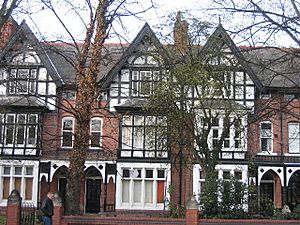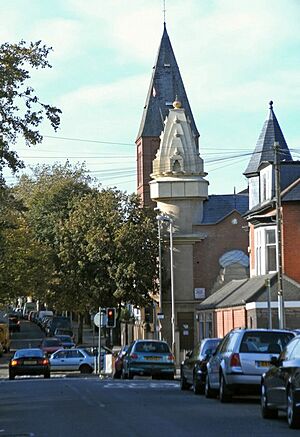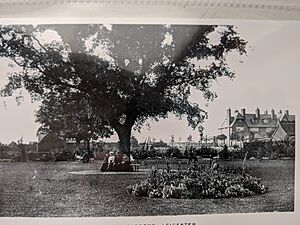Westcotes facts for kids
Westcotes is a lively area located just west of the city of Leicester, England. It's also known as the West End of Leicester. Even though it's a smaller part of the city, it's very popular because it has lots of shops, cool places to eat, and fun spots to hang out. Many students and young people love living here.
The West End is right across the River Soar from the main city centre. Important roads like Braunstone Gate, Hinckley Road, and Narborough Road run through it. Because it's so close to De Montfort University, it's a favourite place for students to live. To the south, you'll find the Braunstone area, and to the west is Dane Hills. This area was built a bit later than other parts of Leicester, so it feels a little more open.
Contents
A Journey Through Time in Westcotes
Ancient Roman Connections
Long, long ago, during the time of the Romans, two important roads crossed through what is now Westcotes. Both of these roads crossed the River Soar near where the West Bridge is today. One road, called the Fosse Way, went southwest all the way from Exeter to Lincolnshire, passing through Leicester. Another road went directly west to connect with Watling Street, another major Roman road.
In the 1970s, archaeologists found the remains of a Roman villa (a fancy Roman house) on Saxon Street, close to the old Mancetter road. This house had cool features like heating under the floor and colourful painted walls. You can still see pieces of these decorations at the Jewry Wall Museum in Leicester!
Medieval and Early Days
The Domesday Book, a famous survey from 1086, shows that Westcotes was once part of an area called Bromkinsthorpe. Much later, in the 1780s, some Roman mosaics (pictures made from small coloured stones) were discovered among cherry tree roots at a place called Danet's Hall. This hall was owned by the Danet family for many years. In 1850, the owner, Dr. Noble, found more Roman items and gave them to the Town Hall. You can see these finds at the Jewry Wall Museum today.
The Victorian Building Boom
After Dr. Noble passed away in 1861, the land at Danet's Hall was sold, and new buildings quickly started to appear. A big project in 1881 helped drain the marshy land near the River Soar. This made it possible to build many new streets and homes to the west of the river. By 1900, much of the area was built up, and it was completely full of buildings within the next 40 years. The way the streets are laid out today is still from that time.
Most of the area was once part of the Westcotes Estate, which is where the name "Westcotes" comes from! This estate was sold over time, and the main house was taken down in 1886.
During the late 1800s, Leicester's industries, like knitting, hosiery, and shoe-making, grew very fast. More workers meant more homes were needed. Many small builders constructed houses in Westcotes, which is why you see so many different styles of Victorian homes there today.
Westcotes in the 20th Century
In the early 1900s, Westcotes was an important place for families to live. Many people who worked in Leicester's big factories, like Liberty Shoes and N. Corah and Sons, lived in the West End. This created a strong community with lots of factory life, sports clubs, and churches.
After World War II, the people living in Westcotes started to change. In 1951, many people from the USSR, mostly Ukrainians, came to live in Leicester. The older terraced houses in Westcotes were perfect for renting. Many Ukrainian men married local women, and a close community formed. Ukrainian services were held at the Church of the Martyrs. This helped keep Ukrainian culture alive in the area. Later, this group bought their own church on Hinckley Road.
By the 1970s, some of the older houses in central Leicester were not in good condition. A plan was made to clear these older homes to make way for better roads into the city. Over 1,000 houses were cleared during this time.
Westcotes Gardens: A Green Space
Westcotes Gardens is a lovely park that was given to the city by Westcotes Estates Ltd. It was laid out and opened around 1905. An old picture from around 1910 shows the houses that still stand today. It also shows an old building that might have been a stable, which is no longer there.
For comparison, there's also a picture taken in 2020 from the same spot in Westcotes Gardens. You can see how the area has changed and stayed the same over the years!





